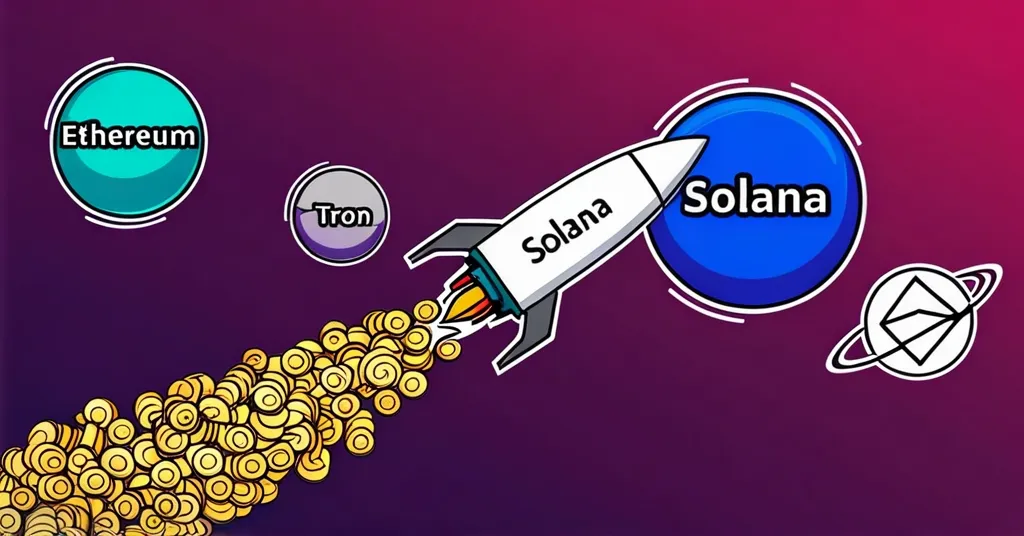Solana Surges Past Ethereum and Tron in Fee Revenue, Ranks 9th Overall

Solana Surges Ahead, Outpacing Ethereum and Tron in Fee Revenue
In a remarkable show of strength, Solana (SOL) has surged past both Ethereum (ETH) and Tron (TRX) in transaction fee revenue, raking in $2.06 million in the last 24 hours alone. This performance has propelled Solana to the ninth spot in cumulative revenue fees, ahead of Ethereum at 17th and Tron at 11th. Such a feat highlights Solana’s growing influence in the blockchain world, driven by high network demand and significantly lower transaction fees compared to its rivals.
- Solana generates $2.06 million in fees in 24 hours
- Ranks 9th in cumulative revenue, ahead of Ethereum and Tron
- Market value at $172.84, up 2.54% in 24 hours
Despite this impressive revenue surge, Solana’s market value hovers at $172.84, with a modest 2.54% increase in the last day. However, its trading volume has dipped by 27.07% to $3.49 billion. This dynamic illustrates Solana’s rise in the blockchain arena while navigating the unpredictable crypto market.
Over the past week, Solana amassed $19.03 million in fees, and an impressive $193.02 million over the last month. In contrast, Ethereum’s gas fees, which are the costs for transactions on its network, totaled $8.85 million over the same week and $74.13 million over the month. Tron, on the other hand, generated $11.93 million and $51.06 million respectively. These figures underscore Solana’s appeal, which stems from its ability to process more transactions per second at lower costs.
Solana’s dominance, according to analysts, could have been fueled by high network demand, which led to increased transaction volumes.
The shift towards Solana isn’t just about the numbers; it’s about the user experience. Ethereum, known as the king of smart contracts, has been battling high gas fees and network congestion. This has driven many users to seek alternatives. Solana, with its lower fees and higher transaction throughput, has become an attractive option.
Users shifted from Ethereum in favor of Solana due to the lower gas fee and higher throughput.
While Solana’s immediate success is undeniable, it’s important to keep perspective. Ethereum and Tron still hold significant positions in the market. Ethereum, despite its challenges, leads in total fee revenue over the long term, and Tron has seen substantial growth, particularly in stablecoin transactions. Solana’s dominance in daily fee revenue is a testament to its growing ecosystem, fueled by platforms like Pump.fun and Raydium, which have significantly contributed to its revenue surge.
However, not all is smooth sailing for Solana. The trend of meme coins and AI concept coins, while lucrative, raises questions about the sustainability of its fee revenue. The blockchain space is notoriously volatile, and what’s hot today might not be tomorrow. Balancing this surge with diversified revenue streams will be crucial for Solana’s long-term stability.
Looking forward, the potential approval of a Solana ETF by the SEC, as predicted by Pantera Capital, could mark a significant milestone. Such an event would not only validate Solana’s growth but also attract more institutional investors, potentially stabilizing and further boosting its market value. Yet, with Ethereum’s ongoing efforts to improve its network through upgrades like Cancun, and Tron’s steady growth, the competition will only intensify.
As we celebrate Solana’s surge, it’s essential to recognize the broader landscape. Bitcoin remains the bedrock of the crypto revolution, offering stability and a foundation for the entire ecosystem. Meanwhile, altcoins like Solana, Ethereum, and Tron each carve out their niches, pushing the boundaries of decentralized technology. While we champion the cause of decentralization and privacy, we must also critically assess the sustainability and long-term impact of these developments.
Here are some key takeaways and questions to consider:
- What factors contribute to Solana’s dominance in transaction fee revenue?
High network demand, lower gas fees, and higher throughput compared to Ethereum are key factors driving Solana’s dominance.
- How does Solana’s revenue performance compare to Ethereum and Tron?
Solana outperforms both Ethereum and Tron in daily transaction fee revenue, ranking ninth overall, while Ethereum and Tron rank 17th and 11th respectively.
- What is the current market value and trading volume of Solana?
Solana’s current market price is $172.84, with a 2.54% increase in the last 24 hours. Its trading volume is down 27.07% at $3.49 billion.
- Why might users be shifting from Ethereum to Solana?
Users are shifting due to Solana’s lower gas fees and higher transaction throughput, making it a more attractive option for network usage.



